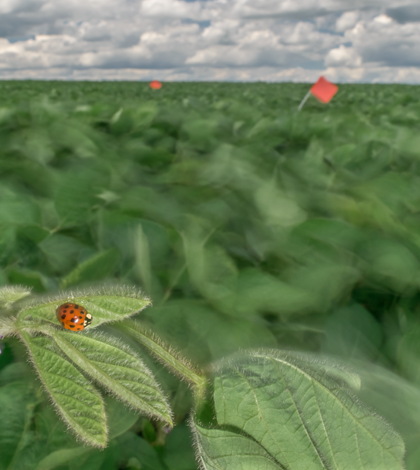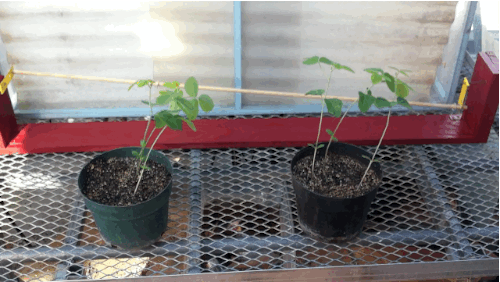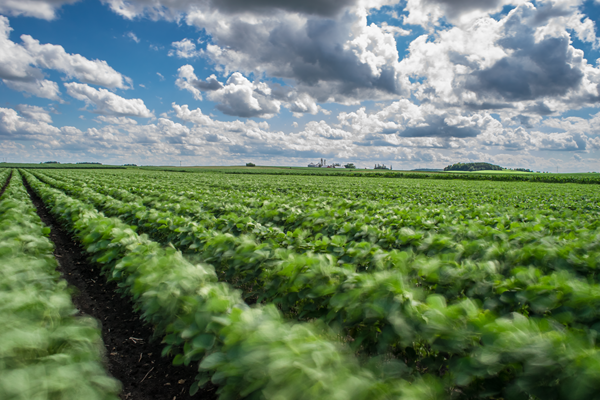As global wind speeds slow, study shows lighter breeze could alter predator-prey interactions

A one-third-second exposure of wind-blown soybeans and a multicolored Asian ladybeetle (Credit: Brandon Barton)
A few years ago, on a day so windy it was tough to stand upright, ecologist Brandon Barton stood among a few flattening experimental plots of corn and alfalfa.
“The corn is almost bending over 90 degrees. The alfalfa fields are being whipped this way and that way,” said Barton, a post-doctoral researcher at the University of Wisconsin’s zoology department. That’s enough to get a food web-oriented mind thinking about what role the wind plays in the interactions between predator and prey species that live on the plans.
“That’s gotta have some effect,” he recalled thinking.
It turns out that it does, at least in the case of ladybugs and aphids crawling around on soybean plants. That’s what Barton found in a recently published study that is among the first to show how varying wind speeds can tip the balance between predator and prey.
The results are particularly interesting in light of “global stilling,” a phenomenon describing a 5 to 15 percent slowing of wind speeds across the planet in the past 30 years that is expected to continue into the 21st century. One suspected cause is that the temperature difference between the poles and the equator, which drives global winds, is shrinking as the poles warm more quickly than the rest of the planet. Humans are also building more buildings and replanting forests, both of which impede wind on the landscape.
The research documenting and modeling global stilling has mostly come from green energy interests that want to know where the wind will blow before they invest in land and build turbines. “These people aren’t doing it because they care about ladybugs,” Barton said.
For his study, Barton began in the lab, where he pointed fans at soybean plants crawling with aphids to test for effects on the prey species without any ladybugs in the picture. He also wanted to isolate the breeze’s jostling effect from its cooling effect, so he engineered a specialized instrument that continuously tugs on plants through a string tied to their stems.
“It’s a two-by-four and a little motor that I put together in my backyard,” he said. “It’s a one-of-a-kind sort of device”

Those tests showed no direct effects on aphids, which can apparently hunker down and go about their business. But when the ladybugs were introduced, the predators on fan-blown or jostled plants took longer to find aphids and ate fewer bugs once they tracked them down.
Field tests had similar results: Ladybugs were larger and more abundant within test soybean plots sheltered from the wind than they were in unprotected plots. As a result, the unprotected plots also harbored nearly twice as many aphids.
Wind speed measurements behind the wind blocks showed that the structures slowed wind by about 50 percent. That’s greater than the projected effects of global stilling over the next century, but the point wasn’t to predict what ladybug and aphid populations will look like in the soybean fields of 2050.

A windy day in the soybean fields of the University of Wisconsin Arlington Agricultural Research Station (Credit: Brandon Barton)
Instead, the study is an early entry into the body of work showing that wind speeds play a defining role in some predator-prey interactions. Other examples include a 2004 study that showed that wind made sparrowhawks on the coast of Scotland less successful at hunting redshanks, a wading bird. And a 2012 study found an increase in wind speeds over the Southern Ocean made more efficient foragers of wandering albatross.
So for now, scientists are still proving the effects of wind speeds on predators and prey, rather than projecting the effects of global stilling on the future soybean market.
“You have to worry about temperature and precipitation and whether you’re going to have drought or a good snowpack,” Barton said. “There are all these other factors that we have to consider before we start extrapolating any of these predictions.”
The research is published in the journal Ecology.
Top image: A one-third-second exposure of a multicolored Asian ladybeetle among wind-blown soybeans at the University of Wisconsin Arlington Agricultural Research Station (Credit: Brandon Barton)





0 comments